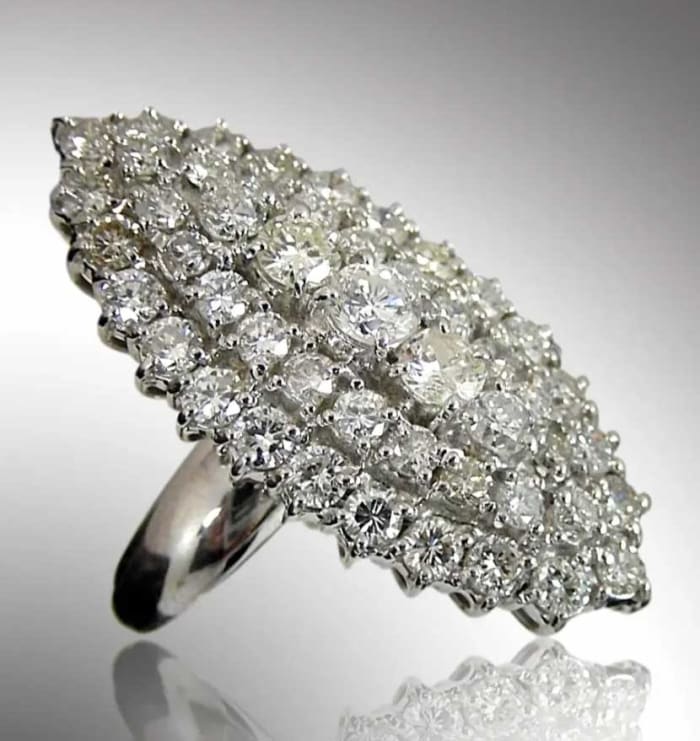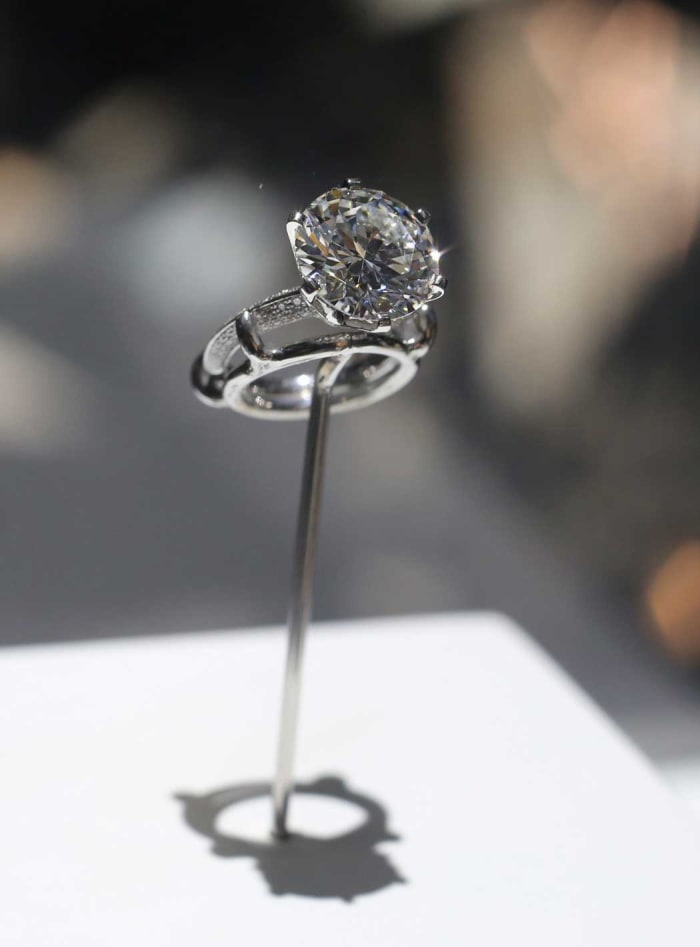With Valentine’s Day fast approaching, thoughts of romance and weddings dance through our heads. Before the wedding, however, there is usually a period called the engagement. This trial-and-error time frame allows the future bride and groom to solidify their relationship in a number of ways. One of the first may be choosing the all-important engagement ring.
The engagement ring through history
Though the diamond engagement ring is a fairly new tradition, the concept of the engagement ring has been around for centuries. The ancient Romans used engagement rings to represent ownership of the future bride. The ring signified a marriage contract was in place and also symbolized the ownership of the daughter would soon transfer from the father to the future groom. In public, the young woman usually wore a gold ring. Back at the house, the gold ring was swapped out for an iron one.
The Romans thought diamonds held supernatural powers and having a diamond in a ring protected the wearer. Pliny the Elder, a renowned philosopher of Ancient Rome wrote, “A diamond baffles poison, keeps off insanity and dispels vain fears.”
Legend has it the tradition of the groom asking the bride’s father for permission to marry his daughter stems from this ring tradition. The groom didn’t actually ask for the bride’s hand in marriage; he requested a transfer of ownership.
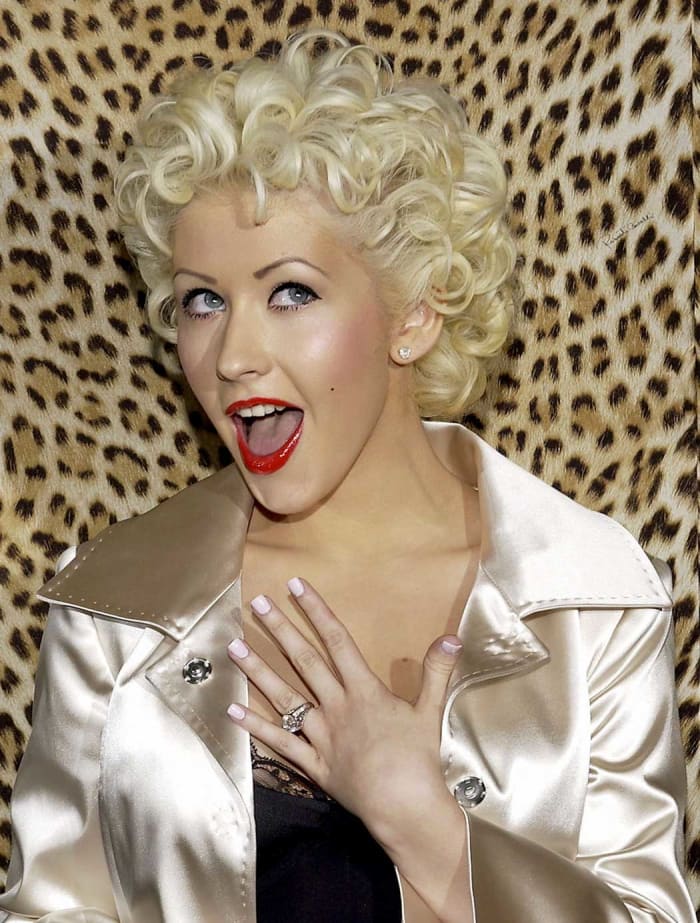
Pop singer Christina Aguilera shows off her diamond engagement ring in Beverly Hills in 2005.
Photo by Amanda Edwards/Getty Images
The first diamond engagement ring
It is believed the first diamond engagement ring was given by the Archduke Maximillian of Austria to his future Queen, Mary of Burgundy in 1477. Diamonds were cut into small pieces to form her initial, “M.” These stones were a very crude version of cut facets, the best technique available at the time. Then, like now, people wanted to follow the fashions of the nobility. Mary’s ring created a new demand for cut diamonds set in rings and other jewelry. It should be noted here, however, that only the nobility were allowed to wear precious gems such as diamonds, rubies and sapphires.
By 1500, artisans developed tools to create facets on diamonds, the earliest design being the rose cut. A fairly simple shape, the stone had facets on all sides, usually six or eight and a small peak in the center, resembling a small rose bud.
Diamonds were extremely rare during the Middle Ages and mined only in India. In the mid-1700s, King Louis XV of France commissioned his jeweler to create a diamond cut to reflect the shape of his mistresses’ mouth, Madame de Pompadour. The resulting shape is now known as the marquise cut or navette cut.
Another French influence came from Baron d’Orchamps, a renowned Oracle in Paris. He declared if a diamond was worn on the third finger of the left hand, it would ward off evil spirits and attract good fortune at the same time. Because he had a high-class following, many women of the upper classes soon clamored for this miraculous diamond ring. Another fashionable must-have was born.
The art and skill of cutting diamonds
Diamonds could only be cut with other diamonds and polished with diamond dust. Artisans with this skill became uncommonly popular. During this time period, the shape of the desired diamonds also changed. The need for better cutting techniques was born.
It wasn’t until the Industrial Revolution when machines were developed that could accurately cut diamonds, creating 58 facets on each stone. The most popular shape or cut from this time period is now known as the Old European or English round cut. To this day, modern round brilliant cut diamonds have the same number of facets: 58 as the Old European cut. When the diamond mines were discovered in Africa in the late 19th century, diamonds became not only extremely popular, but more affordable for the middle and upper classes. Women as well as men wore diamonds in their jewelry.
But, getting back to the engagement ring, the diamond still wasn’t the stone of choice. The Victorians usually chose the bride’s birthstone for the ring. Sometimes the ring spelled out a word using stones to symbolize the first letter. For example, “Dearest” would be depicted using a Diamond, Emerald, Amethyst, Ruby, Emerald, Sapphire and Topaz.
Diamond engagement rings for the masses
Although diamonds have been popular for several hundred years with royalty, it’s only been the past 100 years or so that non-royalty have worn diamonds, especially on the third finger of the lady’s left hand. Back in Victorian times, “Diamonds were very popular but had not as yet become the epitome for engagement rings…birthstones were still considered the favorite stone choice for that occasion.” (Collecting Victorian Jewelry, C. Jeanenne Bell, G.G., pg. 210) Besides using the bride’s birthstone, sometimes the parents of both the bride and groom’s birthstone flanked the bride’s stone. The upper middle class however, began to emulate royalty by wearing diamonds whenever financially possible.
Diamonds began appearing in engagement rings on a regular basis during the Edwardian period. Again, because Royalty often dictated fashion, Alexandra, the wife of King Edward VII, loved diamonds and pearls and often wore diamond rings. From around 1910-1930, sometimes a single diamond, sometimes a diamond set with other fine stones such as rubies and sapphires, became fashionable for those who could afford them in their engagement rings.
However, diamonds were still costly and out of reach for most of the middle class. When diamonds are found in rings from the Edwardian through the Art Deco eras, they are usually small, ranging from .05 to .25 points in carat weight.
The Great Depression
When the Great Depression hit, the use of diamonds in engagement rings came to a screeching halt. More cost effective stones, even fakes, were commonly substituted for a diamond. Spinels, amethysts, citrines and even pearls were used instead.
In the meantime, diamond mines were active in Africa and owned by The DeBeers Company, a cartel of businessmen from England. DeBeers controlled 90 percent of the diamond mines in Africa. By controlling supply, they could command their price.
Because demand for diamonds was down during the Depression, in 1938 they hired an ad agency, N.W. Ayer & Son to ramp up the desire for diamond engagement rings. The slogan “A Diamond is Forever” was born during this ad campaign and still symbolizes the eternal love in marriage. In the year 2000, Advertising Age magazine named this the best advertising slogan of the 20th century.
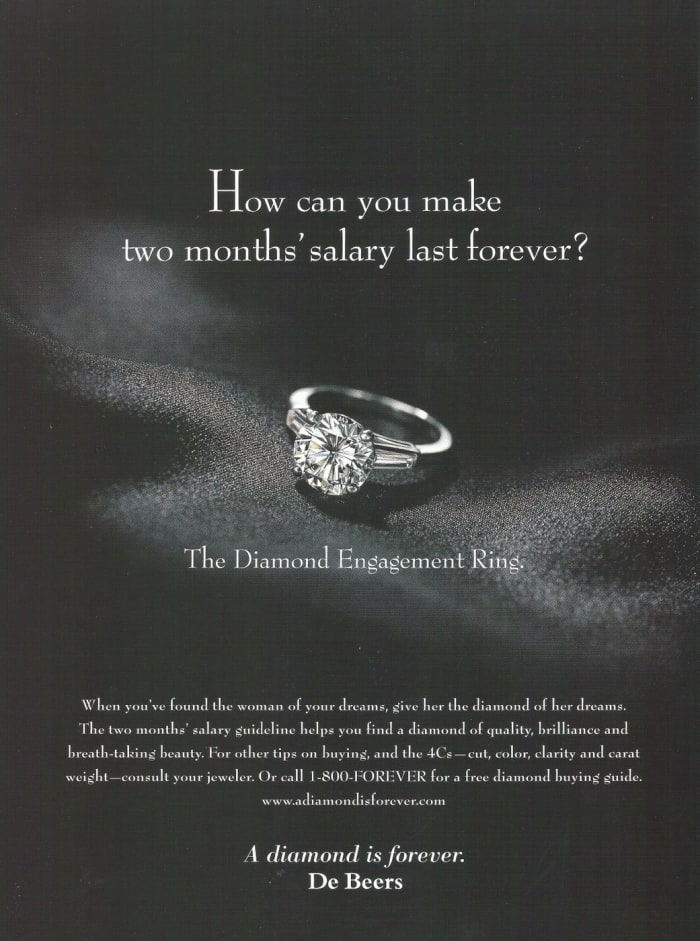
One of the most successful advertising campaigns in history, De Beers’ “A Diamond Is Forever” campaign was launched in 1938.
Not only did the Ayer campaign resuscitate the demand for diamond engagement rings, it also came with a guideline on how much money a groom should spend. Obviously, the larger the diamond, the more successful the groom appeared to be.
How much should the groom spend on a ring?
Some advertisements hinted the groom should spend as much as four months’ salary on the all-important ring. It seems the most common amount was equivalent to one month’s pay. When this portion of the marketing campaign was shown to the chairman of the De Beers Company, he predicted, “The diamond industry would prosper as long as men are foolish and women are vain.”
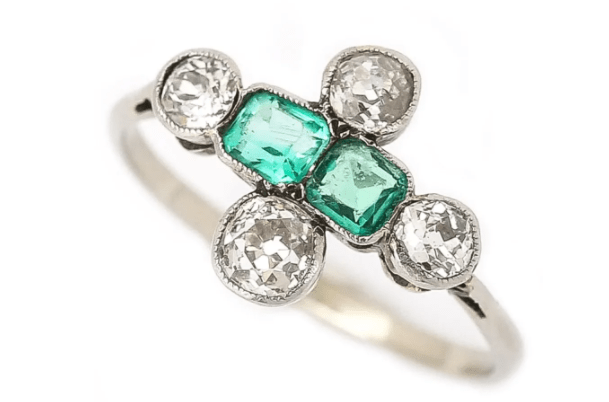
Some engagement rings feature gemstones, in addition to diamonds. An Art Deco platinum, diamond and emerald six-stone engagement ring, circa 1920, $1,790.
Courtesy of Howell 1870/Ruby Lane
Brides’ American Wedding Study found the average couple spent $3,756, on an engagement ring, far less than the $7,829 average spent in 2018. In addition to this marketing blitz, De Beers frequently loaned diamond jewelry to movie stars for special events such as movie debuts and award nights, allowing the stars to flash lots of diamonds for the cameras. Marilyn Monroe and perhaps even Liz Taylor fueled this frenzy for glitz and glamour with famous routines such as, “Diamonds are a Girl’s Best Friend.”
Liz Taylor’s notorious jewelry collection was often photographed and written about, especially the most famous stone of all, the Krupp diamond, a 30 carat stone given to her by Richard Burton, “because it was Tuesday.”
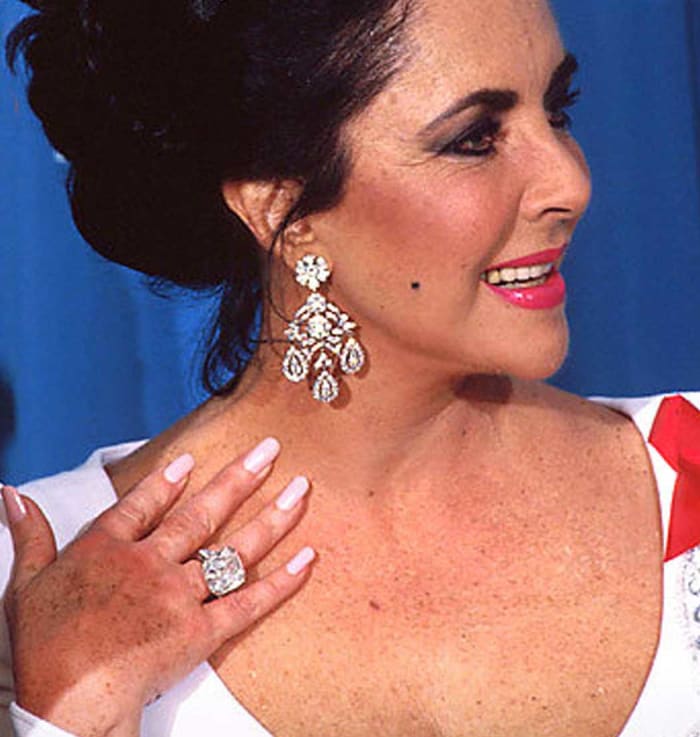
Elizabeth Taylor wearing the Krupp diamond given to her by Richard Burton. When the diamond came up for auction by the Krupp estate in 1968, Burton paid a reported $305,000 for it and presented it to Taylor on their yacht in London. The ring sold at auction for $8.8 million.
Courtesy of Christie’s
Broken engagement? Who gets the ring?
Besides a brilliant marketing campaign, a law on the books called “Breach of Promise to Marry” was disappearing and made inert in many states. This meant women could no longer sue over a broken engagement. Back then, if a woman’s fiancé broke off their engagement, her future marriage prospects were considered grim. Society being what it was, women were often considered “tainted” if they’d had a brush with matrimony that never came to fruition. Thus, the desire for a diamond ring, the larger the better, came into focus.
The ring was a form of insurance. The more money spent on a non-returnable ring, the more likely the would-be groom would go through with the wedding. Even if the wedding was canceled, a girl might not be able to sue for breach of promise, but she sure as heck could keep the rock.
The timing of DeBeers marketing campaign couldn’t have been better. Today, however, with most women working and earning their own living, the diamond ring is less about status and insurance against a broken engagement and more about love and a promised future together.
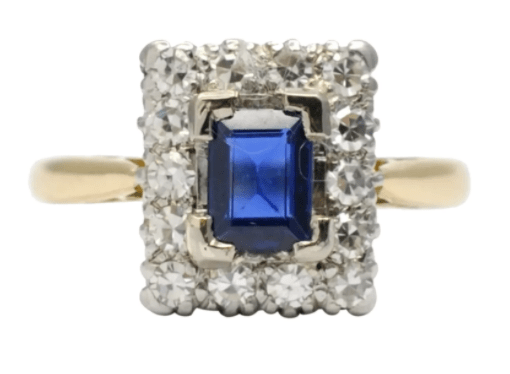
Rectangular sapphire and diamond cluster engagement ring set in 18k gold and platinum, 1920. The deep royal blue sapphire weighs 0.50 carat and is surrounded by 8-cut diamonds totaling 0.42 carat; $1,100.
Courtesy of Plaza Jewellery/Ruby Lane
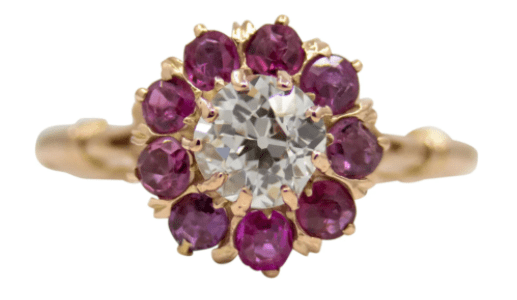
Victorian old mine-cut diamond and ruby engagement ring in 14-carat yellow gold, $2,316.
Courtesy of Dimitri and Co Estate Jewelry/Ruby Lane
Engagement rings out of favor?
Much like the financial necessity during the Great Depression, many brides are now eschewing the large ring, preferring to use the money for other things, such as the actual wedding or perhaps a down payment on a house. Other brides are using less expensive stones. Sapphires and rubies are popular diamond substitutes as well as lesser-known stones, such as moissanite.
Regardless of the stone used, the engagement ring is a tradition here to stay, emblazoned on our psyches thanks to history and a great advertising campaign.
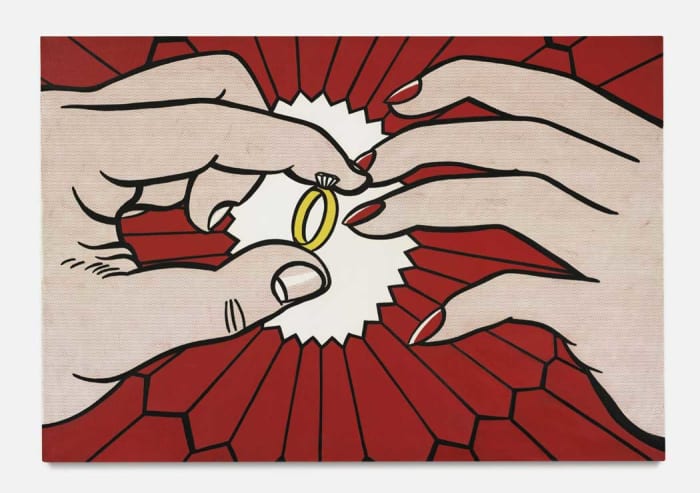
Roy Lichtenstein’s “The Ring (Engagement)” turned the intimate into Pop Art, selling for $41.7M at Sotheby’s.
Courtesy of Sotheby’s


